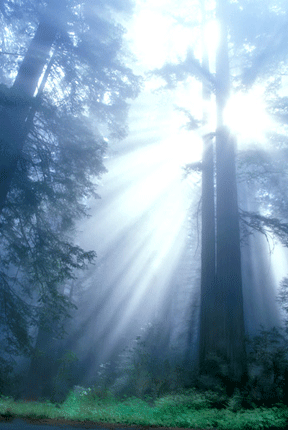Restore, Reinhabit, Re-enchant
What does Forests Forever's motto mean?
'Restore',
"Restoration is a deceptively complex concept. It means regeneration. Return the natural world to the way it was, as best we can, before clear-cutting ... inelegant development, pollution and the industrial accidents of bygone eras harmed the Earth. Give nature a jump start, and stand back."
–David Brower, first executive director of the Sierra Club
David Brower (1912-2000), the legendary conservationist who founded the Earth Island Institute, has written more eloquently than perhaps anyone else about the importance of environmental restoration.
Simply put, restoration means returning the Earth's life-support systems to working order. But to do so, we must drop our hopelessness and put our faith in Nature's ability to regenerate itself. "Exhausted fields can renew themselves," Brower writes. "Grass can annihilate pavement. So long as life lasts, dashed hopes stand a chance."
Humans of course must help nudge the restoration process along by repairing environmental damage. Examples of forest-related restoration activities include:
- Armoring streams and cutbanks
- Revegetating slopes and riparian corridors
- Placing boulders and logs in streams
- Decommissioning roads and developments
- Removing exotic species and reintroducing natives
With simple restoration techniques such as those above, even forests that have been heavily logged can return to conditions mirroring old-growth. One of Forests Forever's primary campaigns is to end large-scale logging in Jackson State Forest and allow the area to return to conditions approximating old-growth.
For an example of hands-on restoration work, visit the Mattole Restoration Council's website at www.mattole.org.
'Reinhabit'

The term 'reinhabit' originated in the bioregionalism movement of the 1970s. Still active today, the movement calls for defining areas based not on ecologically meaningless political boundaries but instead on geographic boundaries and ecological characteristics.
To reinhabit the place where you live means to become aware of these natural boundaries, to become conscious of the landforms, weather patterns, soils, native plants and animals, indigenous human history, and other unique inherent features of the area.
Peter Berg, co-founder of the San Francisco-based Planet Drum Foundation, and a major figure in the bioregionalism movement, calls reinhabitation "a term for undertaking the practice of living-in-place,
In a 1976 essay Berg wrote: "There needs to be a Continent Congress so that the occupants of North America can finally become inhabitants and find out where they are. This time Congress is a verb. Congress, come together. Come together with the continent."

'Re-enchant'
"There is another world. But it is in this one."
–poet Paul Eluard
Over the past two centuries Western thinking has come to be dominated by the Cartesian worldview– one in which nature is reduced to a series of mechanized systems. This view, championed by French philosopher and mathemetician Rene Descartes, holds that the mind and body, Man and Nature, are distinctly separate from each other. According to this view, man is an observer of the cosmos instead of a participant in it.
Such thinking has obscured Nature's intrinsic unity– and its mystery. In his book, "The Reenchantment of the World" Morris Berman writes, "The view of nature which predominated the West down to the eve of the Scientific Revolution was that of an enchanted world. Rocks, trees, rivers and clouds were seen as wondrous, alive, and human beings felt at home in this environment. The cosmos, in short, was a place of belonging."
Re-enchantment is about abandoning the false view that Nature is something that can be ultimately "figured out." It is about recognizing the inherent wonder of Nature, the mystery of life itself.
©2024 Forests Forever. All Rights Reserved.